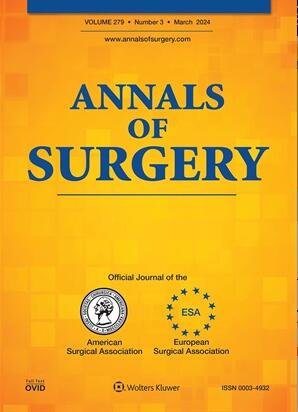微创胆囊次全切除术后胆漏的处理综述。
IF 7.5
1区 医学
Q1 SURGERY
引用次数: 0
摘要
目的:微创胆囊次全切除术是微创胆囊切除术的安全选择,可预防胆管损伤。然而,它与其他并发症的发生率较高相关,即术后胆漏和症状性残余胆石症。数据泄漏表现为胆囊瘤,需要引流,随后胆汁排出量高。与开窗胆囊次全切除术的相关性更强。幸运的是,大多数是自限性的,不需要内镜干预。症状性残余胆石症表现为胆囊切除术后复发性胆石病。方法回顾有关这两种并发症的现有文献,并分享我们在处理胆漏方面的机构算法。结果我们的胆漏治疗方法提倡术中引流管放置,早期诊断泄漏,观察等待,使用造影,对高度泄漏或难治性病例保留ERCP和支架置入术。有症状的残余胆石症与重建胆囊次全切除术更密切相关,特别是在胆囊残端较长或结石未完全从残余胆石中排出的情况下。如果可能的话,这种并发症应采用完全胆囊切除术治疗,但对于胆道解剖异常和/或有严重合并症的患者,也可以采用保留胆囊的胆囊取石术治疗。完全性胆囊切除术是一项技术上具有挑战性的手术,它得益于肝胆胰专业知识和术中辅助技术,如近红外荧光胆管造影或术中胆管造影。结论微创胆囊次全切除术可有效预防胆管损伤,但术后发病率增高;这是一种应该谨慎使用的救助策略。本文章由计算机程序翻译,如有差异,请以英文原文为准。
Management of Bile Leak Post Minimally Invasive Subtotal Cholecystectomy: A Review.
OBJECTIVE
Minimally invasive subtotal cholecystectomy is safe alternative to minimally invasive cholecystectomy that prevents bile duct injury. Nonetheless, it is associated with higher rates of other complications, namely post-operative bile leak and symptomatic remnant cholelithiasis.
SUMMARY BACKGROUND DATA
Bile leak presents as biloma requiring drainage and subsequently high bilious drain output. It is more strongly associated with fenestrating subtotal cholecystectomy. Fortunately, the majority are self-limited and do not require endoscopic intervention. Symptomatic remnant cholelithiasis presents as recurrent gallstone disease post-operative cholecystectomy.
METHODS
In this paper, we review available literature on these two complications and share our institutional algorithm on the management of bile leak.
RESULTS
Our approach to bile leak advocates for intra-operative drain placement, early characterization of the leak, watchful waiting, the use of sinogram, and reserving ERCP and stenting for high-grade leaks or refractory cases. Symptomatic remnant cholelithiasis is more strongly associated with reconstituting subtotal cholecystectomy, particularly in cases where the gallbladder stump is long or stones are not completely evacuated from the remnant. This complication should be treated with completion cholecystectomy when possible, but can also be managed with gallbladder-preserving choleystolithomy in patients with aberrant biliary anatomy and/or significant comorbidities. Completion cholecystectomy is a technically challenging operation that benefits from hepatopancreaticbiliary expertise and intra-operative adjuncts such as near-infrared fluorescent cholangiography or intra-operative cholangiogram.
CONCLUSIONS
Minimally invasive subtotal cholecystectomy effectively prevents bile duct injury but at the expense of increased post-operative morbidity; it is a bailout strategy that should be used judiciously.
求助全文
通过发布文献求助,成功后即可免费获取论文全文。
去求助
来源期刊

Annals of surgery
医学-外科
CiteScore
14.40
自引率
4.40%
发文量
687
审稿时长
4 months
期刊介绍:
The Annals of Surgery is a renowned surgery journal, recognized globally for its extensive scholarly references. It serves as a valuable resource for the international medical community by disseminating knowledge regarding important developments in surgical science and practice. Surgeons regularly turn to the Annals of Surgery to stay updated on innovative practices and techniques. The journal also offers special editorial features such as "Advances in Surgical Technique," offering timely coverage of ongoing clinical issues. Additionally, the journal publishes monthly review articles that address the latest concerns in surgical practice.
 求助内容:
求助内容: 应助结果提醒方式:
应助结果提醒方式:


